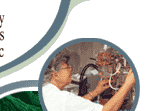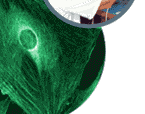- measurement and processing of 3D image data (development of new methods
and SW implementations, applications): 3D image analysis, stereology,
spatial statistics, 3D reconstructions
- first- and second-order stereological methods: studies of method
variance, development of new methods and SW, maintenance of the CAST-GRID (Olympus)
system, consultations, training
- confocal and two-photon microscopy: data analysis, applications of
recent fluorescence methods and two-photon microscopy methods, calibration
measurements, service and maintenance of Leica SP2 AOBS confocal microscope
with 2-photon excitation and Leica SPE microscope, consultations, training; participation in the Centre
„Fluorescence Microscopy in Biological and Medical Research“
- application of methods for processing and evaluation of image data in
studies of biological specimens, e.g. capillaries in human placenta, tooth
pulp, rat muscle and brain, internal structure of Noeway spruce needles, in
studies of cell components, such as nuclear structures and endoplasmic
reticulum
- administration of the computer network in the Krč area and corresponding
services for the Institute of Physiology including administration of www
pages, statistical analyses, coordination of the signalization system,
applied computer graphics
|
|
Research activities of the Department of
Biomathematics are focussed mainly on analysis and measurement of 3-D image data
using stereology, 3-D image processing and computer reconstructions. Further,
consultancy and extensive technical support on networking, computer graphics,
statistics, stereology, and confocal microscopy are provided to the Academy
institutes located in the Krč area but mainly to the Institute of Physiology.
In the Krč area, the following technical support is provided:
-
Administration of the local computer network (LAN) (domain:
biomed.cas.cz) with approx. 1000 stations (PC) and mailboxes. Administration
of servers providing basic services (DNS, DHCP, Mail, Web, Antispam and
Antivirus, Firewall, FTP, Backup).
-
Evaluation of the LAN performance and planning its
further development, taking into account the ever increasing demands on the
LAN performance.
-
Servicing and maintaining two-photon and confocal
microscopes.
The technical support provided to the Institute of
Physiology comprises:
-
Maintenance of the LAN including installation of network
supporting software, administration, maintenance and and upgrading
information displayed at the Institute webpages and Intranet.
-
Consultations in statistics and statistical analyses of
scientific results.
-
Maintenance of the C.A.S.T.- GRID system (Olympus) for
stereology, including consultations on stereological methods.
Research activities of the Department comprise both
the development of new methods and programmes as well as a number of
applications in cooperation with other laboratories. New stereological methods
are developed and implemented together with other methods for the measurement of
volume, surface area, length and other geometrical characteristics of biological
objects, such as characteristics of their spatial distribution. The efficiency
and applicability of the methods are compared at the theoretical as well as
practical level. The design, development and computer implementation of methods
for 3-D image analysis and reconstruction of biological objects from their
serial sections and interactive visualization of these objects also belong to
the priorities. Among the extensive number of the software modules developed,
there are more than 80 modules for stereology, image processing and analysis in
the ELLIPSE (ViDiTo, SR) environment, 150 modules for image processing running
in the IRIS EXPLORER (NAG, UK) programming environment, Rapid 3D software system
for 3D visualization of large specimens, STESYS software for generation of
stereological test systems, and modules in ImageJ environment. The images of
serial sections are captured predominantly by using confocal microscopy. Many
applications, concerning above all confocal microscopy and stereology, run in
cooperation with laboratories of the Institute of Physiology, other Academy
institutes and universities in the Czech Republic and abroad (e.g., Ljubljana in
Slovenia, Loma Linda in USA, Genoa in Italy, Thessaloniki in Greece). Let us
mention studies of the capillary bed of placental villi, skeletal muscle fibres,
brain and tooth pulp tissue, components of chick embryonic kidney, membrane
microdomains in mast cells, anatomical structure of needles, etc. Another source
of serial slices is represented by medical tomographical imaging systems like CT,
MR, SPECT that are located at cooperating institutes in Prague. Exploiting these
sources the problem of registration (alignment) of pictures of neighboring
slices are solved and modern methods for their registration, volume or surface
reconstruction and visualization are developed and implemented. In the framework
of the „Fluorescence Microscopy in Biological and Medical Research“ Centre
applications of recent advanced fluorescence techniques and two-photon
microscopy methods are developed.
Publications
|




